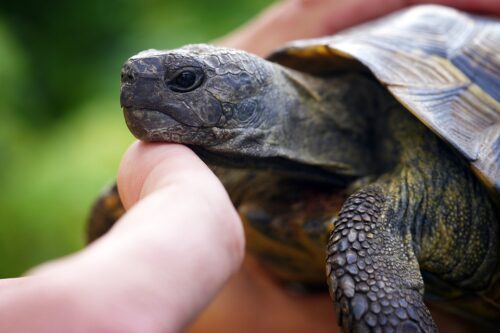Stomatitis in tortoises is also known as “mouth rot” and it’s usually one of the most common issues to afflict a tortoise during and following hibernation. It can also be the result of trauma or infectious disease. Stomatitis can be treated with medication for oral cleaning or injections, depending on the case.
Taking care of a tortoise often seems like child’s play, although the reality is very different. While tortoises seem like low-maintenance pets, they have specific needs that you need to fulfill. An appropriate, clean habitat is somewhere towards the top of the list. You must also maintain the temperature to an optimal level, and you should also be prepared to hibernate your tortoise if they are a hibernating breed.
But that’s not all – tortoises unfotunately also have characteristic health issues, and it’s your duty as an owner to know what to do and how to treat these issues. Stomatitis is one such problem, and if it’s left untreated, the tortoise will be forced to deal with a lot of health problems aside from the intial discomfort it brings. Today, we will talk about stomatitis and see how it can be prevented and treated.
What Is Stomatitis and Why Are Tortoises Prone to this Problem?
Stomatitis, also called “mouth rot”, is an infection that affects the oral cavity of the tortoise. This inflammation of the mouth will cause trauma or discharge to the mouth, and this is all due to bacteria in its oral cavity.
In general, this problem occurs when the immune system of the reptile becomes weaker, and while the bacteria in the tortoise’s mouth is usually not harmful, but it’s a different story if the immune system is compromised. Stomatitis might also occur if a tortoise has an unrelated illness.
If left untreated, the condition may get worse over time, ultimately spreading down the pet’s esophagus (food pipe). In the worst scenarios, the mouth rot can may even reach the tortoise’s lungs, which not only causes further tissue damage but also puts it at a marked increased risk of death.
Tortoises are usually prone to stomatitis due to hibernation. When they hibernate, their metabolism slows right down, leading to a reduction in the efficacy of the immune system. This illustrates the need to make sure you know exactly what you’re doing when putting your tortoise into hibernation.
Consequently, the tortoise cannot fight off any infection, which is what may lead to stomatitis. Tortoises are also more likely to get mouth rot if they belong to someone who doesn’t know how to take proper care of their tortoise. Improper diet and living conditions may reduce immune function, making stomatitis more likely to rear its ugly head.
How to Recognise If Your Tortoise Has Stomatitis?
Generally, it’s hard to spot stomatitis in its early stages, because the visible signs don’t show up until the infection has become well established. As such, getting to know your tortoise very well might allow you to notice that something is wrong, as you’ll be accustomed to the normal behavior and appearance of your pet.
If you notice sudden changes in behaviour and appearance, it might mean that stomatitis has made some progress, and it’s crucial to take action before things progress further and the risk of serious complications becomes greater.
- Discomfort
Tortoises don’t exactly wear their emotions on their sleeve, which is what makes it pretty hard to notice when something’s wrong. Nevertheless, the discomfort will become obvious. For example, they might become more lethargic than usual, or they might, in fact, walk around their enclosure more than they normally do. Defensive or shy behavior is also a sign that something is not right.
- Loss of Appetite
If you had inflammation inside your mouth, you would almost certainly experience difficulty while eating. The tortoise goes through the same thing when stomatitis takes hold. Since it forms inside the tortoise’s oral cavity, it will make eating a very uncomfortable experience. If your tortoise isn’t usually a fussy eater and it suddenly starts eating less, the first thing to do is check its mouth, and it may quickly become apparent that stomatitis might be the cause.
- Trauma or Discharge
Following on from the previous point; physical signs might also appear, and when they start to become a problem to the torotisem they will likely be pretty apparent to you.
When stomatitis is the problem, there will be inflammation inside the tortoise’s mouth, such as redness. Sometimes, this may be accompanied by ulcers or even bleeding.
Drooling is another symptom that shows up when stomatitis has settled in. Excessive drooling in a tortoise is never normal.
Also, if the tortoise keeps its mouth open due to the discomfort, then it’s a clear sign that you should start taking action.
How to Treat Stomatitis?
In the case of stomatitis you shouldn’t attempt to treat the tortoise by yourself. The right thing to do is take it to the vet immediately. Otherwise, things might get worse, leading to further illness.
The vet will probably ask you questions about the tortoise, its overall husbandry, when the strange behavior started, and so on. After giving the diagnosis, adequate treatment will start.
Usually, mouth rot is treated using certain medications for mouth cleaning. It may be necessary to avoid doing any further damage to the tissue, though, which may rule out some treatments, while antifungal agents or antibiotics may be required. These might come in the form of oral medications or injections.
How to Prevent Stomatitis?
Preventing stomatitis is both possible and necessary. Here’s what you have to do:
- Look in the Enclosure
Your tortoise always needs to have proper care and living conditions, or else it might be affected by mouth rot. The humidity and temperature of the enclosure should be optimal. Temperatures should be no cooler than 76 F (24 degrees C) and no higher than 86 F (30 degrees C). As for humidity, it should be between 50-70%.
- Clean the Enclosure
The enclosure should always be clean, or else it may become a hotbed for pathogens, which might weaken the immune system of the tortoise. Spot clean every day and throw away food leftovers after 2-3 hours. Eliminate the feces the moment you see them and change drinking water on a daily basis. The bedding should be fully changed once every one or two months.
- Offer a Balanced Diet
A good diet is also important in preventing stomatitis. A balanced diet containing foods rich in vitamins, such as Vitamin C, which is crucial for the immune system, should be provided.
- Take Extra Care With Hibernation
As stomatitis is prone to developing whilst a tortoise hibernates, you should be absolutely sure they are in peak physical health prior to entering their hibernative state.
This means checking they are of a sufficient weight to have enough in reserve to burn whilst hibernating, but also that they have been sustained on a healthy diet, and that there are no outstanding health concerns or injuries that might make them an easy target from an infection.
It’s a really good idea to have a vet give your tortoise general checkup prior to hibernation, just to be on the safe side.
Final Thoughts
Tortoises are prone to stomatitis, but you can prevent the issue by maintaining a clean enclosure, offering the right living conditions, and making sure it has a balanced, vitamin-rich diet. However, if you notice any signs of mouth rot, make sure to visit the vet as soon as possible.


